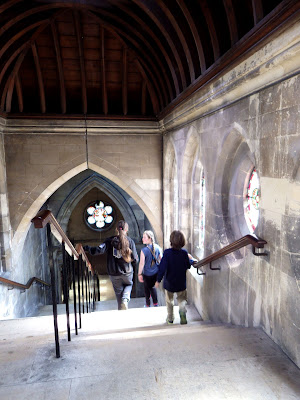The "What We Call Love" exhibition at IMMA in Dublin is so large, and there is much to remember about it. I particularly liked this delicate piece by Louise Bourgeois. As I said previously, I am more familiar with her large-scale works, but the small works are just as powerful in their expression of intimacy. The embracing figures are hand sewn soft sculptures and this looks to be a hand blown glass enclosure, reminding one of a bell jar.
I personally don't think any discussion of love can take place without a mention of John & Yoko, so I was pleased to see a few photos of them in a political section of the exhibition -- from the Montreal bed-in, their wedding at Gibraltar and a picture from The Acorn Project.
There were Irish artists also included in the show. I have long admired the work of sculptor Dorothy Walker, so was delighted to see some of her work that I hadn't seen before. The Passion Bed, 1993, is a delicate piece made of steel wire and sandblasted wine glasses.Here is a detail of it:
Garrett Phelan is another Irish artist whose work I am familiar with. I first met Garrett when he was working in Temple Bar Gallery & Studios at the time of my first solo exhibition, and have bumped into him a few times over the past 20 or so years. It was delightful to meet him again at the IMMA launch. Below is one of his pieces that were included in the show, New Faith Love Song. Unfortunately the other other piece, a gorgeous gold reliquary specially commissioned for this show is too new to find its image on the web, and the launch was too crowded for me to get a good photo of it!
I can't remember when or where I saw a whole exhibition of Rebecca Horn's complex machine installations (The Tate Modern or IMMA?) but I enjoyed seeing her work again. The photo of course cannot show the sound and movement in the piece -- the steel "arrow" tapping against one of the glass funnels, the guns moving until they randomly face each other perfectly and shoot liquid at each other.
IMMA touts this as its "most ambitious exhibition to date" and it most definitely is. I am only skimming the top of the barrel with my blog. The exhibition includes nearly 200 works of national and international importance and interest. In addition to the artists that I have highlighted there is also work by Andy Warhol, Damien Hirst, Nan Goldin, Marina Abramovich, Meret Oppenheim, Felix Gonzalez-Torres, Jean Genet -- the list goes on. The exhibition continues to Feb 7 2016, see it if you can! Further information at imma.ie.



























